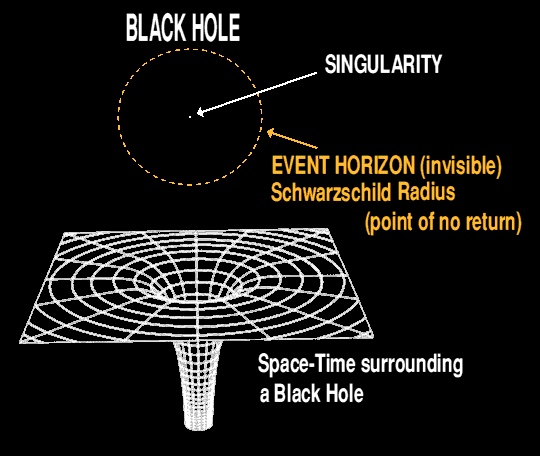

Neutron stars are formed from the gravitational collapse of the inner core of a large star following a supernova explosion. The inner core must be between 1.4 and 3 solar masses for a neutron star to form after the explosion, any greater and a black hole will form instead. Newly created black holes born this way are between 3 and 5 solar masses. Those larger that 5 solar masses must have grown from smaller ones by accretion. The majority of stellar black holes are between 5 and 20 solar masses. There are also monstrous black holes at the centre of most if not all galaxies; these have grown by gobbling stars and other black holes. They can have a mass of more than a million solar masses.
If all the matter of the Sun were compressed to fit within 3km radius then it could not resist collapsing and becoming a Black Hole of 3km Schwarzschild radius. Any body greater than 3 solar masses will eventually collapse to a Black Hole. Self-gravitational forces vary with mass squared. Once within the Schwarzschild radius, nothing can leave, not even light, and must journey onwards to the central singularity. The Schwarzschild radius limit arises when the escape velocity of the body equals the speed of light. Since nothing can travel faster than light, nothing can escape when it goes within the Schwarzschild radius, or event horizon.
It has now been proved experimentally that gravity also travels at the speed of light. This means that once a black hole forms, not even the gravitational fields within it can escape the event horizon. The gravitational field around a black hole is said to be due to the gravitational field of the collapsing mass just before it passed the event horizon. It is a static field.
Far from the Black Hole the space-time is asymptotically flat, but becomes progressively distorted as the singularity is approached, becoming infinitely deep at the singularity where it is not a part of our Universe.
Although it is not expected that Black Holes possess electrical charge, being formed from neutral objects like suns, most objects in the Universe are rotating and it would be impossible for a non-rotating Black Hole to form from the collapse of a spinning object. Only for a non-rotating, chargeless Black Holes does the Schwarzschild radius coincide with the Event Horizon, the point of no return. For rotating or charged Black Holes, things are different. Since a chargeless non-spinning black hole has just one property, its' mass, it has but one event horizon. As more and more matter is attracted into a Black Hole, the event horizon grows bigger. This process of accretion is accompanied by the emission of immense power; swallowing matter is not a 100% efficient process - as the matter is accelerated towards the Black Hole and before it had had the chance to pass the Schwarzschild Radius, the matter gets intensely hot and radiates X-rays and gamma rays. Paradoxically, an accreting Black Hole can look white hot. In the process of devouring matter, a Black Hole can radiate away up to 15 times more mass as energy than can a fusion bomb or a star.
Gravity is so intense around a Black Hole that space has curved around upon itself such as to 'disconnect' it from our 'Universe', but it can still be felt. To outside observers, time stands still at the Schwarzschild radius. The size of the Schwarzschild radius is proportional to the mass of the Black Hole, and is solar-system sized for galaxy-mass black holes, and proton sized for Everest-mass Black Holes.
The surface gravity at the event horizon is inversely proportional to the mass of the black hole, as is its' characteristic temperature. Thus for a super-massive black hole, you could stand just above the event horizon and it feel just like Earth gravity. But for much smaller black holes, where the gravitational field changes faster, the difference in the gravitational force exerted on you at your head and at your feet would tear you apart. This is the tidal force. Tidal forces vary as the inverse cube of the distance from the singularity. A small 10 mega sun mass black hole would have a surface gravity 150×109 times that of Earth.
The radius of the event horizon, r, is directly proportional to the mass of the black hole, r=2Gm/c2.
The entropy of a black hole is proportional to the square of its' mass, and is proportional to the area of the event horizon.
A group of theorists have recently (2005) used string theory to model a 10-dimensional Black Hole as a liquid and come up with what may be an insight into the viscosity of real liquids on Earth. They found that the ratio of the viscosity to the entropy density is a constant for a 10-dimensional Black Hole. This may suggest a lower limit to the ratio of viscosity to entropy in real liquids. So far they haven't found any real liquid that is less viscous. Water, for example, is 400 times that limit, and even superfluid liquid helium is nine times that limit. It is suggested that a super-cold clouds of atoms that is in a Bose-Einsten Condensate state could approach the limit, as could a plasma of sub-atomic particles created in particle colliders.

There is another alternative to the formation of a Black Hole, a Preon Star.
![]()
![]()